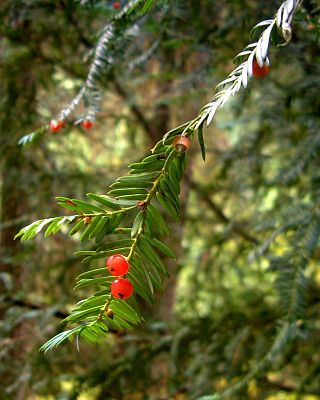
A bean is the seed of several plants in the family Fabaceae, which are used as vegetables for human or animal food. They can be cooked in many different ways, including boiling, frying, and baking, and are used in many traditional dishes throughout the world.

Phaseolus is a genus of herbaceous to woody annual and perennial vines in the family Fabaceae containing about 70 plant species, all native to the Americas, primarily Mesoamerica.

Phaseolus acutifolius, also known as the tepary bean, is a legume native to the southwestern United States and Mexico and has been grown there by the native peoples since pre-Columbian times. It is more drought-resistant than the common bean and is grown in desert and semi-desert conditions from Arizona through Mexico to Costa Rica. The water requirements are low. The crop will grow in areas where annual rainfall is less than 400 mm (16 in).

Phaseolus coccineus, known as runner bean, scarlet runner bean, or multiflora bean, is a plant in the legume family, Fabaceae. Another common name is butter bean, which, however, can also refer to the lima bean, a different species.

A lima bean, also commonly known as the butter bean, sieva bean, double bean or Madagascar bean is a legume grown for its edible seeds or beans.

Phaseolus vulgaris, the common bean, is a herbaceous annual plant grown worldwide for its edible dry seeds or green, unripe pods. Its leaf is also occasionally used as a vegetable and the straw as fodder. Its botanical classification, along with other Phaseolus species, is as a member of the legume family Fabaceae. Like most members of this family, common beans acquire the nitrogen they require through an association with rhizobia, which are nitrogen-fixing bacteria.

Lablab purpureus is a species of bean in the family Fabaceae. It is native to sub-Saharan Africa and India and it is cultivated throughout the tropics for food. English language common names include hyacinth bean, lablab-beanbonavist bean/pea, dolichos bean, seim or sem bean, lablab bean, Egyptian kidney bean, Indian bean, bataw and Australian pea. It is the only species in the monotypic genus Lablab.

Taxus brevifolia, the Pacific yew or western yew, is a species of tree in the yew family Taxaceae native to the Pacific Northwest of North America. It is a small evergreen conifer, thriving in moisture and otherwise tending to take the form of a shrub.

Vaccinium myrtilloides is a shrub with common names including common blueberry, velvetleaf huckleberry, velvetleaf blueberry, Canadian blueberry, and sourtop blueberry. It is common in much of North America, reported from all 10 Canadian provinces plus Nunavut and Northwest Territories, as well as from the northeastern and Great Lakes states in the United States. It is also known to occur in Montana and Washington.

Prosopis glandulosa, commonly known as honey mesquite, is a species of small to medium-sized, thorny shrub or tree in the legume family (Fabaceae).

Monarda fistulosa, the wild bergamot or bee balm, is a wildflower in the mint family Lamiaceae, widespread and abundant as a native plant in much of North America. This plant, with showy summer-blooming pink to lavender flowers, is often used as a honey plant, medicinal plant, and garden ornamental. The species is quite variable, and several subspecies or varieties have been recognized within it.

Shepherdia argentea, commonly called silver buffaloberry, bull berry, or thorny buffaloberry, is a species of Shepherdia in the Oleaster family.

Ipomoea pandurata, known as man of the earth, wild potato vine, manroot, wild sweet potato, and wild rhubarb, is a species of herbaceous perennial vine native to North America. It is a twining plant of woodland verges and rough places with heart-shaped leaves and funnel-shaped white flowers with a pinkish throat. The large tuberous roots can be roasted and eaten, or can be used to make a poultice or infusion. When uncooked, the roots have purgative properties.

Viburnum nudum is a deciduous shrub in the genus Viburnum within the muskroot family, Adoxaceae.

Strophostyles is monophyletic three-species genus of flowering plants in the family Fabaceae, subfamily Faboideae. Common names for the genus include wild bean and fuzzybean. It consists of annual and perennial herbaceous vines, ranging in their native distribution from Nevada, east to Florida, and north to the Great Lakes and eastern Canada. The etymology of the name is strophe (turning) + stylos (style), referring to the curve of the style within the keel petal.

Prunus caroliniana, known as the Carolina laurelcherry, Carolina cherry laurel, Carolina cherry, or Cherry laurel, is a small evergreen flowering tree native to the lowlands of Southeastern United States, from North Carolina south to Florida and westward to central Texas. The species also has escaped into the wild in a few places in California.

Gaultheria hispidula, commonly known as the creeping snowberry or moxie-plum, and known to Micmaq tribes of Newfoundland as Manna Teaberry, is a perennial spreading ground-level vine of the heath family Ericaceae. It is native to North America and produces small white edible berries. It fruits from August to September. Its leaves and berries taste and smell like wintergreen.

Strophostyles helvola, commonly called amberique-bean, annual sand bean, or trailing fuzzybean is a species of flowering plant in the legume family. It is native to eastern Canada and the eastern United States.
Phaseolus angustissimus is a perennial, herbaceous vine of the Fabaceae (legume) family, native to the American Southwest, as well as northern Sonora, Mexico. It is a close relative of the cultivated tepary bean, also native to the same region.




















